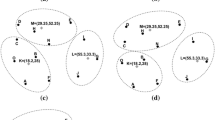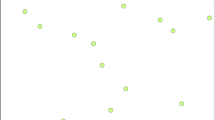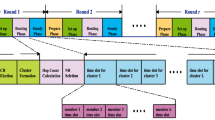Abstract
In recent years, mobile sink based data collection is more popular because of various advantages such as energy-efficient, minimize the isolated nodes, longer the network life, etc. However, visiting each sensor node using a mobile sink is complex, and it may cause data loss or delay during the data collection. However, the number of mobile sinks will proportionally increase the deployment and maintenance cost, and it is challenging to manage them efficiently. In this context, this article proposes an efficient method to identify the best set of mobile sinks that are sufficient to gather the data packets to schedule over the network. The proposed work optimize the network lifetime by merging the three suboptimal operations such as clustering, local and global mobile sink trajectory constructions. Initially, a hierarchical clustering strategy is used to determine clusters and the optimal set of clusters is decided using a modified gap statistic approach. We consider the number of mobile sinks depends on the number of clusters. Afterwords, we proposed a computational geometry model to schedule a mobile sink for each cluster. An additional global mobile sink is scheduled in WSN to collect the data from each mobile sink scheduled at each cluster and it handover the data to the base station. Our model decides the optimal number of mobile sinks, which are required to collect the data from the WSNs efficiently with minimal sensor nodes energy consumption, delay, with longer network lifetime during the data transmissions.













Similar content being viewed by others
References
Praveen Kumar, D., Tarachand, A., & Rao, A. C. S. (2019). Machine learning algorithms for wireless sensor networks: A survey. Information Fusion, 49, 1–25.
Najjar-Ghabel, S., Farzinvash, L., & Razavi, S. N. (2020). Mobile sink-based data gathering in wireless sensor networks with obstacles using artificial intelligence algorithms. Ad Hoc Networks, 102243, 66.
Singh, S. K., & Kumar, P. (2020). A comprehensive survey on trajectory schemes for data collection using mobile elements in WSNs. Journal of Ambient Intelligence and Humanized Computing, 11(1), 291–312.
Liu, X., Obaidat, M. S., Lin, C., Wang, T., & Liu, A. (2020). Movement-based solutions to energy limitation in wireless sensor networks: State of the art and future trends. IEEE Network, 6, 66.
Kumar, P., Amgoth, T., & Annavarapu, C. S. R. (2018). ACO-based mobile sink path determination for wireless sensor networks under non-uniform data constraints. Applied Soft Computing, 69, 528–540.
Donta, P. K., Rao, B. S. P., Amgoth, T., Annavarapu, C. S. R., & Swain, S. (2019). Data collection and path determination strategies for mobile sink in 3D WSNs. IEEE Sensors Journal, 20(4), 2224–2233.
Donta, P. K., Amgoth, T., & Annavarapu, C. S. R. (2020). An extended ACO-based mobile sink path determination in wireless sensor networks. Journal of Ambient Intelligence and Humanized Computing. https://doi.org/10.1007/s12652-020-02595-7.
Anwit, R., Tomar, A., & Jana, P. K. (2020). Tour planning for multiple mobile sinks in wireless sensor networks: A shark smell optimization approach. Applied Soft Computing, 97, 106802.
Hojjatinia, H., Jahanshahi, M., & Shehnepoor, S. (2021). Improving lifetime of wireless sensor networks based on nodes’ distribution using gaussian mixture model in multi-mobile sink approach. Telecommunication Systems, 66, 1–14.
Mukhtar, M. F., Shiraz, M., Shaheen, Q., Ahsan, K., Akhtar, R., & Changda, W. (2021). Rbm: Region-based mobile routing protocol for wireless sensor networks. Wireless Communications and Mobile Computing, 6, 66.
Wen, W., Chang, C.-Y., Zhao, S., & Shang, C. (2018). Cooperative data collection mechanism using multiple mobile sinks in wireless sensor networks. Sensors, 18(8), 2627.
Zhu, C., Quan, K., Han, G., & Rodrigues, J. J. (2018). A high-available and location predictive data gathering scheme with mobile sinks for wireless sensor networks. Computer Networks, 145, 156–164.
Faheem, M., & Gungor, V. C. (2018). MQRP: Mobile sinks-based QoS-aware data gathering protocol for wireless sensor networks-based smart grid applications in the context of industry 4.0-based on internet of things. Future Generation Computer Systems, 82, 358–374.
Doostali, S., & Babamir, S. M. (2020). An energy efficient cluster head selection approach for performance improvement in network-coding-based wireless sensor networks with multiple sinks. Computer Communications, 164, 188–200.
Srinivas, M., Donta, P. K., & Amgoth, T. (2020). Finding the minimum number of mobile sinks for data collection in wireless sensor networks. In 2020 IEEE international conference on communication, networks and satellite (Comnetsat) (pp. 256–260). IEEE.
Yim, Y., Mo, H.-S., Kim, C., Kim, S.-H., Leung, V. C., & Lee, E. (2020). Virtual tube storage scheme for supporting mobile sink groups in wireless sensor networks. Computer Communications, 6, 66.
Keskin, M. E., & Yiğit, V. (2020). Maximizing the lifetime in wireless sensor networks with multiple mobile sinks having nonzero travel times. Computers & Industrial Engineering, 148, 106719.
Liu, X., Lin, P., Liu, T., Wang, T., Liu, A., & Xu, W. (2020). Objective-variable tour planning for mobile data collection in partitioned sensor networks. IEEE Transactions on Mobile Computing. https://doi.org/10.1109/TMC.2020.3003004.
Liu, X., Qiu, T., Zhou, X., Wang, T., Yang, L., & Chang, V. (2019). Latency-aware path planning for disconnected sensor networks with mobile sinks. IEEE Transactions on Industrial Informatics, 16(1), 350–361.
Tao, M., Li, X., Yuan, H., & Wei, W. (2020). UAV-aided trustworthy data collection in federated-WSN-enabled IoT applications. Information Sciences, 6, 66.
Krishnan, M., Yun, S., & Jung, Y. M. (2019). Enhanced clustering and ACO-based multiple mobile sinks for efficiency improvement of wireless sensor networks. Computer Networks, 160, 33–40.
Koosheshi, K., & Ebadi, S. (2019). Optimization energy consumption with multiple mobile sinks using fuzzy logic in wireless sensor networks. Wireless Networks, 25(3), 1215–1234.
Faheem, M., Butt, R. A., Raza, B., Ashraf, M. W., Ngadi, M. A., & Gungor, V. C. (2019). Energy efficient and reliable data gathering using internet of software-defined mobile sinks for WSNs-based smart grid applications. Computer Standards & Interfaces, 66, 103341.
Lakshminarayanan, R., & Rajendran, P. (2019). Efficient data collection in wireless sensor networks with block-wise compressive path constrained sensing in mobile sinks. Cluster Computing, 66, 1–12.
Kumar, V., & Kumar, A. (2019). Improving reporting delay and lifetime of a WSN using controlled mobile sinks. Journal of Ambient Intelligence and Humanized Computing, 10(4), 1433–1441.
Peixoto, J. P. J., & Costa, D. G. (2017). Wireless visual sensor networks for smart city applications: A relevance-based approach for multiple sinks mobility. Future Generation Computer Systems, 76, 51–62.
Kharati, E., Khalily-Dermany, M., & Karmajani, H. (2019). Increasing the amount of collected data using network coding and continuous movement of mobile sinks in wireless sensor networks. IET Networks, 9(3), 128–138.
Najjar-Ghabel, S., Farzinvash, L., & Razavi, S. N. (2019). HPDMS: high-performance data harvesting in wireless sensor networks with mobile sinks. The Journal of Supercomputing, 66, 1–29.
Farzinvash, L., Najjar-Ghabel, S., & Javadzadeh, T. (2019). A distributed and energy-efficient approach for collecting emergency data in wireless sensor networks with mobile sinks, AEU-International Journal of. Electronics and Communications, 108, 79–86.
Deng, R., He, S., & Chen, J. (2016). An online algorithm for data collection by multiple sinks in wireless-sensor networks. IEEE Transactions on Control of Network Systems, 5(1), 93–104.
Yang, S., Adeel, U., Tahir, Y., & McCann, J. A. (2016). Practical opportunistic data collection in wireless sensor networks with mobile sinks. IEEE Transactions on Mobile Computing, 16(5), 1420–1433.
Restuccia, F., & Das, S. K. (2016). Optimizing the lifetime of sensor networks with uncontrollable mobile sinks and QoS constraints. ACM Transactions on Sensor Networks (TOSN), 12(1), 1–31.
Aravind, A. R., & Chakravarthi, R. (2020). Fractional rider optimization algorithm for the optimal placement of the mobile sinks in wireless sensor networks. International Journal of Communication Systems, 6, e4692. https://doi.org/10.1002/dac.4692
Tibshirani, R., Walther, G., & Hastie, T. (2001). Estimating the number of clusters in a data set via the gap statistic. Journal of the Royal Statistical Society: Series B (Statistical Methodology), 63(2), 411–423.
Day, W. H., & Edelsbrunner, H. (1984). Efficient algorithms for agglomerative hierarchical clustering methods. Journal of Classification, 1(1), 7–24.
Sah, D. K., Cengiz, K., Donta, P. K., Inukollu, V. N., & Amgoth, T. (2020). Edgf: Empirical dataset generation framework for wireless sensor networks. Computer Communications. https://doi.org/10.1016/j.comcom.2021.08.017
Amrizal, M. A., Guillen, L., & Suganuma, T. (2019). An analytical approach for optimizing data transfer rate in a faulty wireless sensor network. In 2019 IEEE 24th Pacific Rim international symposium on dependable computing (PRDC) (pp. 122–1221). IEEE.
Donta, P. K., Amgoth, T., & Annavarapu, C. S. R. (2020). Congestion-aware data acquisition with q-learning for wireless sensor networks. In IEEE international IOT, electronics and mechatronics conference (IEMTRONICS) (pp. 1–6). IEEE.
Moridi, E., Haghparast, M., Hosseinzadeh, M., & Jassbi, S. J. (2020). Fault management frameworks in wireless sensor networks: A survey. Computer Communications, 155, 205–226.
Author information
Authors and Affiliations
Corresponding author
Additional information
Publisher's Note
Springer Nature remains neutral with regard to jurisdictional claims in published maps and institutional affiliations.
Rights and permissions
About this article
Cite this article
Srinivas, M., Amgoth, T. Data acquisition in large-scale wireless sensor networks using multiple mobile sinks: a hierarchical clustering approach. Wireless Netw 28, 603–619 (2022). https://doi.org/10.1007/s11276-021-02845-2
Accepted:
Published:
Issue Date:
DOI: https://doi.org/10.1007/s11276-021-02845-2




